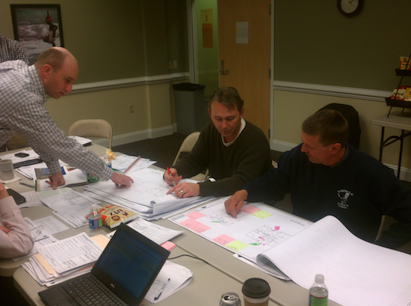For the past five years, my colleagues and I have spent 90 percent of our time helping builders, suppliers, and trade contractors implement Lean process and methods all across the U.S., Canada, Australia, and Mexico. We will soon reach the milestone of our one-hundredth Lean implementation, and that provides us with a huge experiential database with every type and size of builder imaginable. Based on our experience, we are frequently asked: What is the ultimate key to making Lean work in an organization? That’s a great question, and one that I have avoided with aplomb because it begs other questions that are exceedingly difficult to answer. As you have already learned in the title of this article, the answer is culture, but I wish it were something simpler and more tangible. How do you describe a culture? How do you measure it? How do you create the 10 steps that make it transferable?
In my ongoing article series on Lean operations in Professional Builder, I have addressed everything from Lean measurement to scheduling to training required to support Lean, but I have written about culture only in vague terms, with good reason. Want examples of how Lean design impacts costs? That is easy to show in both pictures and plans. Need to understand how Lean and scheduling go hand-in-hand? I can show you great charts and a list of 25 essential practices. Want to know how to measure for Lean? I can list measurements for product, process, systems, departments, and individuals. But culture is a different animal. It doesn’t lend itself well to traditional measurement. It doesn’t even lend itself well to definition. Culture is truly one of those “I know it when I see it” issues, and given that, the best approach is to describe what it looks like, or perhaps more aptly, what it sounds like in a committed organization.
Professional Builder selected Jagoe Homes as its 2010 Builder of the Year for a lot of good reasons. They have been around for four generations. They have built a large and still growing company in tertiary markets — the ones that most large builders never give much thought to. They have a great management team, dedicated employees, and are financially strong. They are highly process-oriented, and when they could not find software to track the business the way they run it, they spent a ton of time and money to invent their own. Jagoe is also one of the best implementers of Lean culture I have encountered. What’s different about Jagoe than most builders in that regard? This is where it gets tough.
First and foremost, surrounding their finely honed processes is an attitude of openness. They have processes and systems that absolutely work and produce continual success, yet they are always seeking improvement. This should not be taken lightly, as it is quite unusual. I’ve worked with many builders who have implemented highly effective systems. More often than not, that is accompanied by a certain confidence, if not outright arrogance, that closes doors to change and improvement. How does Jagoe maintain this openness? It really comes down to brothers Bill and Scott Jagoe, who own the company, and their nephew, Brad Jagoe, who runs the construction operations. These guys are good and they know it, yet they welcome input from anyone, whether it be an employee, supplier, trade, developer, or investor. They may or may not agree, but they are always ready to listen, and there is no fear of retribution for bringing up even a sensitive issue. They are all about getting better, every day.
DSLD Homes, PB’s 2011 Builder of the Year, exhibits similar traits. The company has grown from zero to nearly 800 units in three years. You’d think that would have them feeling pretty full of themselves. On the contrary, if you ask their CEO, Saun Sullivan, just how good they are, he will sincerely tell you “we stink” and rattle off a long list of things he wants the company to do better. Having worked with more than 200 builders in my career, I can tell you emphatically that DSLD is at the top in terms of builder excellence. But Sullivan could care less about my or anyone else’s pronouncements on that. He is not in the top tier by his personal standards, and that’s what matters to him. He visits more builders than any CEO I know to learn what other successful firms do, and he always takes some of his people with him. He also invites builders to come and visit his operations and seeks their feedback. This model of openness and learning sets a compelling example for the entire DSLD team.
Other firms come to mind that exhibit the kind of Lean culture that enables and encourages continual growth in their pursuit of Lean. They include Providence Homes in Jacksonville, Fla.; Goodall Homes in Gallatin, Tenn.; Trendmaker Homes in Houston; and De Young Properties in Fresno, Calif. Strong Lean cultures are not limited to American builders, though. Canadian builders such as The Rohit Group in Edmonton and Laebon Homes in Red Deer, Alberta, certainly qualify, as does Reid’s Heritage Homes of Cambridge, Ontario. And
I’d be remiss if I did not include one of the best groups of people I have ever worked with: the folks from Grady Homes in Townsville, North Queensland, Australia. In each of these firms you find an open, welcoming culture of learning and exploration — a place where it is not just encouraged but expected that you will challenge anyone, anywhere in the name of continual improvement of product and process. In this regard, people and companies are the same everywhere. In this type of culture, people thrive.
Keystone Custom Homes, an award-winning Lancaster, Pa.-based builder has actually grown in their very difficult market and has made great strides in Lean application. No one does a better job of integrating suppliers and trades into the Lean culture, institutionalizing the continual search for and removal of waste. Recently, Keystone launched a next-level effort that I had never seen before. The company’s supplier/trade Lean council has been functioning effectively for more than a year, but they wanted to take it deeper than the 10 current team members could accomplish. They devised a system called “Lean Confederations,” whereby each council member is responsible for a small group of suppliers and trades, keeping them informed and gathering their improvement recommendations. I have seen no better indicator that a company “gets it” than this effort to infuse the Lean operating culture into the entire trade base.
Many have written about a “culture of execution,” which I call the “dog on bone” types. These are organizations that once they get a hold of an opportunity, they refuse to let it go until it is implemented. Many builders come to mind, but among the most notable is History Maker Homes in Fort Worth, Texas. If you show an opportunity to Nelson Mitchell, the builder’s third-generation CEO, there will be no shortage of focus and determination until it’s done and banked. That “just do it” attitude permeates the company.
In Lean implementation, the culture must extend to include the suppliers and trades. There is simply no other way. Here is an acid test. Think about the last time a supplier or trade challenged your firm or you personally with an idea that differed from your status quo. Perhaps they presented the dollars to be gained from using a different product or the costs they incur in building your prized new plans. Now ask this of yourself and your colleagues: When a supplier or trade suggests a change or improvement is your bias to:
A: Believe him and work hard to prove there is something there to produce savings?
B: Doubt him and work hard to prove there is nothing there?
Or, if a supplier suggests a product or process you tried three years ago with no success, do you:
A: Tell her, “Been there, done that, didn’t work, so let’s move on”?
B: Tell her, “Okay, tell me more about that. What has changed or what can we do differently that might make this work?”
These same types of responses apply to your own employees, as well. For the next few weeks, put yourself in a listening mode and keep a notepad or your iPad handy. Pick up on the cues and clues in what your people are saying that indicates the state of your culture. To get you started and tune your ear to the positive and negative expressions of culture floating around your company, I polled TrueNorth field consultants and clients who have had success in Lean implementations. Here is a collection of what they have heard — and not heard — in the best organizations during their Lean process implementations:
20 things you WON’T hear in a lean culture:
- I don’t care what it costs the trade; it’s included in their bid. Extra trips don’t count.
- We tried that before and it didn’t work, so don’t bother.
- We do it this way because we’ve always done it this way.
- That’s not my job.
- The plan is different than what we build in the field. It’s more of a guideline.
- We had to get it done to meet the closing date. The “punch guys” will take care of it.
- We can’t close because a cabinet was damaged by the electrician; now we are waiting for more doors to come in.
- We can’t trust the trades.
- That cannot change because it is a sacred cow.
- Don’t even ask. That’s a (insert company president’s name) thing.
- We looked into that years ago; you won’t find savings there.
- That will take too long to implement.
- I won’t rock the boat talking about problems.
- We dual-source and frequently re-bid to keep our trades honest.
- We don’t have enough time or people to fix the things that are taking all of our time.
- We spend too much time babysitting (superintendent or trade).
- It’s just $50. We can pass that on to the customer.
- I bury extra-trip charges in the bid because your houses are never ready.
- Why am I saving the trades money? We won’t ever see it.
- We just cannot find good trades around here.
20 things you WILL hear in a lean culture:
- Saving my trade a few dollars is just as important as saving me a few dollars. We are all in this together.
- How much will that save us annually?
- All savings ideas are worth consideration. There is always a better way, so bring it on.
- Would the home buyers willingly pay for that if they knew the cost?
- Why is there a credit for materials on this job? Find out why we paid for having materials delivered, then returned.
- We work with a supplier’s internal supply chain to help them find savings so they can reduce their cost.
- Let’s examine our POs and direct costs to ensure materials are coming to the job in the most efficient way.
- We don’t buy on bid price; we buy on total cost.
- How can we change the (process, plan, procedure, product, etc.) so that we can provide the customer the same or better value at less cost? Can we plow some savings back into added features to grab market share?
- I’ll increase my cost to do ABC so that you can reduce your cost by doing XYZ, and we’ll share the savings.
- Fine, so the inspector won’t listen; we’ll just have to try another angle.
- How many other plans can we make that change to?
- Let’s get input from everyone involved to make sure this change sticks.
- I know we tried this five years ago and it failed, but we should try again because…
- How can we help this guy to help us long term?
- Our competitor is doing it, so we better understand it.
- I know that was a completely different plan, but maybe the same principle applies.
- How do we know if we don’t try?
- I have this crazy idea…
- Help!
It may be difficult to describe the culture required for Lean process, but if you listen to those in your company and your suppliers and trades, you’ll get a good handle on it.
A company’s culture is always determined by senior management. Can a middle manager or supervisor taint a culture? Certainly. But only if senior management allows it. So who is ultimately responsible? That’s obvious. The good news is senior management has the power to change that culture, and sometimes with remarkable speed. There is no greater opportunity to ensure the ongoing success of your company. Get the culture right and everything else is easy.
Scott Sedam is president and founder of TrueNorth Development. He and his seven TrueNorth colleagues focus on the adoption of Lean Operating principles into the home-building industry, serving more than 200 builder and supplier clients in the U.S., Canada, and Australia. Sedam welcomes your feedback at scott@truen.com.













